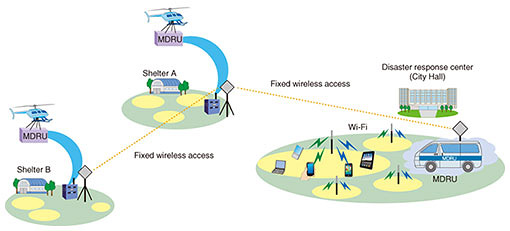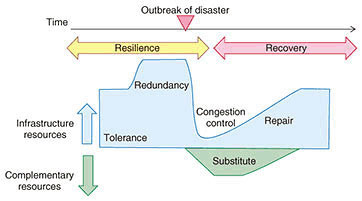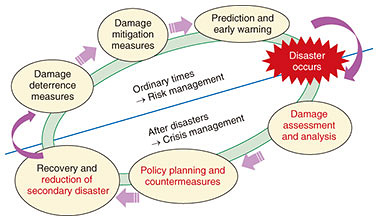 |
|||||||||||
|
|
|||||||||||
|
Global Standardization Activities Vol. 16, No. 10, pp. 77–82, Oct. 2018. https://doi.org/10.53829/ntr201810gls ICT Standardization Trends for Disaster Relief, Network Resilience, and Recovery by ITU-TAbstractThe Great East Japan Earthquake in March 2011 led to standardization of resilient information and communication technology (ICT) such as disaster relief systems, network resilience, and recovery measures by the International Telecommunication Union - Telecommunication Standardization Sector (ITU-T). Additionally, use cases of resilient ICT services/systems in several countries have been summarized and reported in ITU-D (ITU Telecommunication Development Sector). This article reports on the recent progress in standardization related to resilient ICT in the ITU. Keywords: ITU-T, disaster relief, network resilience 1. IntroductionOver seven years have passed since the Great East Japan Earthquake struck in March 2011, and since then, various natural disasters have occurred in Japan and around the world, including the Kumamoto earthquake in April 2016. Since the Great East Japan Earthquake, research and development of disaster-response information and communication technology (ICT) has been promoted in collaboration with academia and industry, and a disaster-resistant ICT research center was established in Japan by the National Institute of Information and Communications Technology. In line with the proposal by Japan in 2012, the International Telecommunication Union - Telecommunication Standardization Sector (ITU-T) established a time-limited investigation group called the Focus Group on Disaster Relief Systems, Network Resilience and Recovery (FG-DR&NRR) that studies standardization of disaster relief systems and ways to achieve resilient ICT during disasters. The focus group created eight deliverables between 2012 and 2014 [1]. The deliverables include many research and development results on disaster-tolerant ICT from Japan. Disaster relief services and disaster tolerant ICT and their requirements that need to be newly standardized are indicated in the deliverables, and some of them are discussed in the ITU-T Study Groups (SGs) that result in new ITU-T Recommendations. In addition, a use case document was produced, in which case examples from Japan and around the world were collected, and the information was also shared with the ITU Telecommunication Development Sector (ITU-D), which is highly relevant for developing countries, and is utilized as a technical report [2]. This article reports on the recent progress in standardization related to ICT for disaster relief systems, network resilience, and recovery by the ITU. 2. Progress in relevant Recommendations by ITU-T SG2ITU-T SG2 (operation aspects and numbering) is a lead study group on disaster relief systems, network resilience, and recovery in ITU-T, and it approved the following Recommendations based on the deliverables transferred from FG-DR&NRR.
A new draft Recommendation on terms and definitions for DR&NRR and the supplementary document on framework of disaster management for disaster relief systems are also being studied. 2.1 Disaster relief mobile message serviceThe new Recommendation ITU-T E.108, which was proposed by Japan, was approved in January 2016. The functions described in this Recommendation are already being offered by NTT DOCOMO in the Disaster Message Board service, which can be used to check on the safety of family and friends via mobile phones and smartphones in the event of a disaster [3]. An outline of this service is shown in Fig. 1. In the event of a large-scale disaster, users in the affected areas can register their own situations and check the registered safety information through the Internet. It is possible to send notifications by email to predesignated family members and friends, or to request users in a disaster area to register their safety information.
Recommendation E.108 provides requirements for safety information required for disaster message board services, requirements for search and display functions, and requirements for mutual provision of services by different mobile phone operators. It also describes the interface requirements of the voice message board service that can be used by foreigners and people with disabilities. 2.2 Safety confirmation and broadcast message service for disaster reliefThe new Recommendation ITU-T E.119, which was also proposed by Japan, was approved in April 2017. This Recommendation describes services that support the business continuity plan of important organizations such as local governments, public institutions such as police and fire departments, telecommunications carriers, medical facilities, and other organizations at the time a disaster occurs as well as after the disaster. It is very important for the full implementation of disaster relief activities. This service is mainly divided into two functions: safety confirmation and message delivery. Outlines of the safety confirmation service and the message delivery service are respectively shown in Fig. 2 and Fig. 3. Safety confirmation is carried out automatically by optimal means such as email, fax, mobile phone, and the Internet so that information about staff members can be exchanged in the event of a disaster. Then messages to the designated team members and/or employees are broadcast so that they can be dispatched to the appropriate workplaces and work sites. This Recommendation states requirements related to system reliability, security, language, and operability.
3. Progress in relevant Recommendations by ITU-T SG15In ITU-T SG15 (transport, access and home networks), the following Recommendation and a Supplement have been respectively approved and agreed, based on the deliverables transferred from FG-DR&NRR via ITU-T SG2.
3.1 Disaster management with movable and deployable ICT resource unitsThe new Recommendation ITU-T L.392, which was proposed by Japan, was approved in April 2016. L.392 proposes a means of early recovery of communication facilities and provides application guidelines to enable the immediate provision of ICT services by transporting, installing, and setting up movable and deployable ICT resource units (MDRUs) [4] to disaster areas. An example of MDRU implementation is shown in Fig. 4.
The MDRU is a portable unit that houses equipment necessary for providing ICT services. In the event of a disaster, the MDRU is transported to the affected area and quickly installed. It is possible to construct a local Wi-Fi network in a short period of time and to immediately provide minimum necessary ICT services in the affected area. Also, by using the remaining optical fiber cable and satellite communication line, the MDRU can connect to the wide area network and function as a network hub in the disaster area. The Appendix to this Recommendation introduces as an example information on ITU demonstration experiments using an MDRU conducted in the Philippines, which suffered tremendous damage caused by high waves in November 2013. This technology was used as a communication tool in some affected areas after the Kumamoto earthquake in Japan in April 2016 and was utilized to support restoration work. Also, in cooperation with the Ministry of Internal Affairs and Communications of Japan in 2017, the ITU decided to introduce the MDRU as a disaster emergency communication system in disaster areas around the world for the purpose of promptly restoring communication services during a disaster [5]. 3.2 Framework of disaster management for network resilience and recoveryThe new Supplement ITU-T L.sup.35, which was proposed by Japan, was agreed in June 2017 and gives countermeasures and guidelines for each phase of disaster occurrence, that is, preparation before disaster occurrence, response/relief immediately after the disaster strikes, and restoration/reconstruction in the short and long term after the disaster. This document recommends network redundancy and congestion control and application of alternative networks specialized for disasters as countermeasures against disasters (Fig. 5). The MDRU mentioned above is also cited as an alternative network at the time of a disaster. Also, effective technologies and network forms/functions for disaster response are listed in the Appendix.
4. Progress in ITU-DITU-D is a development sector within the ITU and has issued a technical report on the utilization of telecommunications/ICT for disaster preparedness, mitigation, and response in various countries including information described in the FG-DR&NRR deliverables [2]. This report describes the fundamental approaches to disaster risk management using ICT, the formulation of a disaster countermeasure strategy, and country use cases that are not standardized but are considered to be useful for disaster relief, and also useful for improving the tolerance (resilience) of communication facilities and reducing damage in the event of a disaster (Fig. 6). The report also provides as an example Japan’s use of MDRUs after the Kumamoto earthquake in April 2016. This report is a document on disaster response guidelines mainly for developing countries and is considered useful for devising disaster countermeasures.
5. Future activitiesThe ITU continues to make progress in standardizing ICT for disaster response. Disaster countermeasures vary depending on the kind of disaster, the infrastructure situation of the country/region, and the environmental conditions due to the topography and climate, and the technical field is very wide. Nevertheless, we believe that the Recommendations and the Supplement, which summarized the common requirements for disaster response ICT, will be useful in the future to minimize the damage caused by disasters. References
|
|||||||||||















